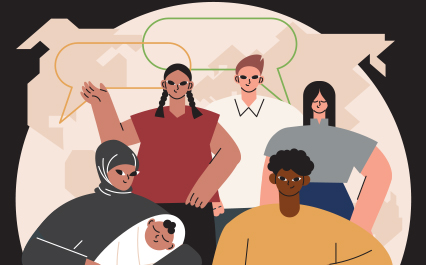Page Content

RACIST LANGUAGE IS COMMON, complicated and, in some cases, highly contextual. Words that may have been politically correct in the past can evolve to be viewed as microaggressions, epithets or slurs. While our society expects people to be conscious of offensive words and to speak with inclusivity, there’s no doubt that racial language is a minefield, regardless of a person’s skin colour.
Adding to the complexity is the reality that there is fluidity to how people wish to see themselves. Describing a person’s race based on their physical attributes is not the same as describing ethnicity based on origins, so determining what’s safe to say is dependent on how people wish to be identified. The best way to address this puzzling question is to just ask the person. Since that’s not always possible, here are some guidelines.
SAFE TO SAY
AFRO CANADIAN AND AFRICAN CANADIAN reflect identities with pride in their African descent. Preference toward using the Afro or African prefix reflects belonging to the African diaspora regardless of where one has migrated. But the name is impractical for people who are not Black yet originate from African countries. The prefix “African” falsely insinuates that African identity is assumed to homogeneously belong to the Black race. The African prefix is also misleading as Africa is not a country, colour or racial category.
BLACK is accepted as a term that organizes the community as a broad ethnicity. It gained popularity and preference over the label “coloured” during the early 1970s with the rise of the Black Power movement. It is spelled with a capital B because it is an ethnic group name and designated as a proper noun. It is not a colour adjective to describe Black people.
CARIBBEAN CANADIANS have origins from the more than 7,000 Atlantic islands. It is acceptable when this is an accurate reflection of those being referenced.
USE WITH CAUTION
BIPOC is used as an acronym for Black, Indigenous and People of Colour. While this acronym is convenient, it’s preferable to distinguish each community by using their proper name, e.g. Black, Indigenous, Lantinx, etc. Identifying people by name or nation is best, e.g. Nigerian, Trinidadian, Cree etc.
BIRACIAL/MIXED RACE Biracial is used when Black people identify with another ethnicity. Some prefer mutiracial, multiethnic and mixed race to include their diverse identities. Mixed is not always accepted, as it neutralizes identity. Do not use mulatto as it’s rooted in disparaging Spanish language origins.
COMMUNITIES/PEOPLE OF COLOUR are acceptable terms to corral all people who would identify as nonwhite, but it is passive. It lacks effort to properly recognize people by their preferred ethnic identity. It also creates a hybrid of all other ethnicities, which defaults to making people feel like outsiders.
AVOID
APE/MONKEY
Words associated with apes and other animals discriminate against Black people as they are extremely dehumanizing and demeaning.
AUNT JEMIMA is but one example of a brand that is offensive because it reflects oppressive and subservient stereotypes.
BOY is a pejorative word that discriminates against Black men as inferior.
COLOURED is both unsettling and complicated. It minimizes the qualities of Black people. The term was self-assigned by Black people to separate themselves from the N-word that slave owners used. It was replaced by “Black” and evolved to the prefix “African” as the community sought less disparaging titles. The National Association for the Advancement of Colored People (NAACP) formed as a civil rights group in 1909, and it has remained acceptable to use the term coloured in this context.
CODED WORDS refers to everyday language with racial undertones. Examples are blacklist (to be unwelcome or banned), hood and ghetto (impoverished or low quality), white knight (a saviour of others), and colour descriptors such as chocolate or cocoa skin, which exoticize ethnic features.
EXOTIC is a racially camouflaged term to characterize Black people, especially women, as uncommon. It draws specific attention to physical features that are considered rare and unique in Western culture. Unwanted attention toward textured hair and dark features demeans one’s identity by reducing them to being alien or mysterious. It reinforces that being white is the acceptable default culture.
NEGRO should be considered an antiquated term to identify Black people in the English language. In the 20th century, the term evolved from the indignity of the N-word that slave masters used. Negro replaced the term coloured and was preferred by Americans when spelled with a capital “N”. In the 1960s it fell out of favour and was replaced by the term Black. When used today, Negro is an expression of a colour bias that upholds racial hegemony and stereotypes. This includes being viewed as chattel or property, or as a threat.
THE N-WORD is the paramount of racial slurs. It is not a name, direct object or casual reference to a race. These six letters represent a total disregard for human life due to the barbaric and murderous conditions that Black people suffered from the cradle to the grave for centuries. The N-word continues to be associated with a belief that Black people are intrinsically inferior to others and that this inferiority continues to be inherited. In an anti-racism world, the N-word is only of value to Black people. The N-word or any variations of it should not be said, sung or written by people outside of the Black community.
VISIBLE MINORITY is an outdated term of Canadian origins. First used in 1975, it separates noncaucasions from white people socially and in federal legislation. It is racially divisive because it emphasizes that collectively people of colour belong in spaces that are not white. This term also applies to mixed race people. Indigenous people in Canada are not considered visible minorities.
Additional resources:
www.rsdb.org/full
www.racialequitytools.org/glossary
www.diversitystyleguide.com/
www.aclrc.com/glossary (Alberta Civil Liberties Research Centre)
www.crrf-fcrr.ca/en/resources/glossary-a-terms-en-gb-1
